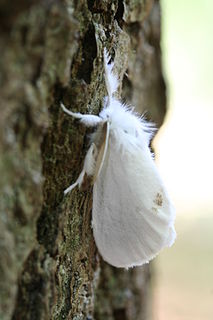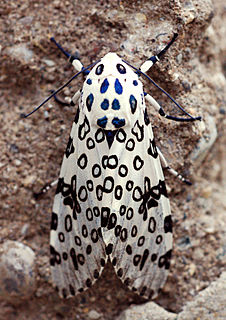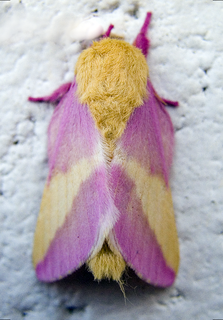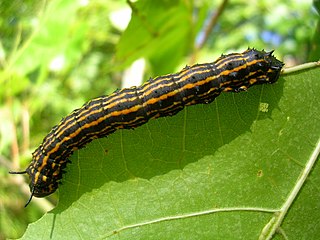
The yellow-tail, goldtail moth or swan moth is a moth of the family Erebidae. The species was first described by Johann Kaspar Füssli in 1775. It is distributed throughout Europe to the Urals, then east across the Palearctic to Siberia. It is also found in Sri Lanka.

The giant leopard moth is a moth of the family Erebidae. They are distributed through North America from southern Ontario, and southern and eastern United States through New England, Mexico and down to Panama. The obsolete name Ecpantheria scribonia is still occasionally encountered.

Protographium marcellus, the zebra swallowtail, is a swallowtail butterfly native to the eastern United States and southeast Canada. It is the state butterfly of Tennessee. Its distinctive wing shape and long tails make it easy to identify, and its black-and-white-striped pattern is reminiscent of a zebra. The butterflies are closely associated with pawpaws, and are rarely found far from these trees. The green or black caterpillars feed on the leaves of various pawpaw species, while the adults feed on flower nectar and minerals from damp soil.

Eacles imperialis, the imperial moth, is a Nearctic member of the family Saturniidae and subfamily Ceratocampinae. The species was first described by Dru Drury in 1773.

Acraea terpsicore, the tawny coster, is a small, 53–64 millimetres (2.1–2.5 in), leathery-winged butterfly common in grassland and scrub habitats. It belongs to the Nymphalidae or brush-footed butterfly family. It has a weak fluttery flight. It is avoided by most insect predators. This species and the yellow coster are the only two Indian representatives of the predominantly African tribe Acraeini. It is found in India, Sri Lanka, Maldives to Myanmar, Thailand, Laos, Cambodia, Vietnam, and Singapore.

Dryocampa rubicunda, the rosy maple moth, is a small North American moth in the family Saturniidae, also known as the great silk moths. It was first described by Johan Christian Fabricius in 1793. The species is known for its wooly body and pink and yellow coloration, which varies from cream or white to bright pink or yellow. Males have bushier antennae than females, which allow them to sense female pheromones for mating.

Daphnis nerii, the oleander hawk-moth or army green moth, is a moth of the family Sphingidae. It was described by Carl Linnaeus in his 1758 10th edition of Systema Naturae.

Theretra oldenlandiae, the impatiens hawkmoth, taro hornworm or white-banded hunter hawkmoth, is a member of the family Sphingidae.

Anisota senatoria, the orangestriped oakworm, is a Nearctic member of the family Saturniidae and subfamily Ceratocampinae. It is one of the more common Saturniids, reaching pest status occasionally in the northern parts of its range. As they are late-season feeders, however, they do little lasting damage to their hosts. It is very similar to A. finlaysoni in southern Ontario and A. peigleri in the southern US. The species was first described by James Edward Smith in 1797.

Hemaris thysbe, the hummingbird clearwing, is a moth of the family Sphingidae (hawkmoths). Coloration varies between individuals, but typically the moth is olive green and burgundy on its back, and white or yellow and burgundy on the underside. Its wings are transparent with a reddish-brown border. It has light-colored legs, which combined with the lack of striping on the underside is diagnostic. Beating its wings rapidly, H. thysbe hovers to collect nectar from a variety of flowers. The combination of its appearance and its behavior commonly leads to it being confused with a hummingbird or bumblebee.

The nine-spotted moth or yellow belted burnet is a moth in the family Erebidae. The species was first described by Carl Linnaeus in his 1758 10th edition of Systema Naturae.

Deltote bankiana, the silver barred, is a moth of the family Noctuidae. The species was first described by Johan Christian Fabricius in 1775. It is found in the Palearctic.

Utetheisa pulchella, the crimson-speckled flunkey, crimson-speckled footman, or crimson-speckled moth, is a species of moth of the family Erebidae. The species was first described by Carl Linnaeus in his 1758 10th edition of Systema Naturae.

Hypsoropha is a genus of moths of the family Erebidae. The genus was erected by Jacob Hübner in 1818.

Estigmene acrea, the salt marsh moth or acrea moth, is a moth in the family Erebidae. The species was first described by Dru Drury in 1773. It is found in North America, the Democratic Republic of the Congo, Kenya, Colombia and Mexico.

Grammodes stolida, the geometrician, is a moth of the family Erebidae. The species was first described by Johan Christian Fabricius in 1775. It is found in Africa, southern Europe, most of Asia and Australia. It migrates to central and northern Europe as far north as England, Denmark and Finland.

Thyas coronata is a species of moth of the family Noctuidae first described by Johan Christian Fabricius in 1775. It is found from the Indo-Australian tropics of southern China, Taiwan, Japan, Nepal, India, Sri Lanka to Micronesia and the Society Islands.

Catochrysops strabo, the forget-me-not, is a small butterfly found in Asia that belongs to the lycaenids or blues family. The species was first described by Johan Christian Fabricius in 1793. It is found in Sri Lanka, India, from Sikkim to Indochina and in Sundaland, Sulawesi and the Philippines.

Hypsoropha hormos, the small necklace moth, is a moth of the family Erebidae. The species was first described by Jacob Hübner in 1818 and it is found in the southeastern United States.

Polytela gloriosae, the Indian lily moth or lily caterpillar, is a moth of the family Noctuidae. The species was first described by Johan Christian Fabricius in 1781. It is found in Sri Lanka, India and probably in Indonesia.



















